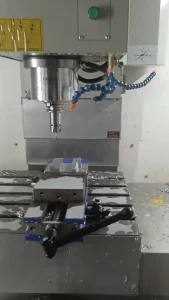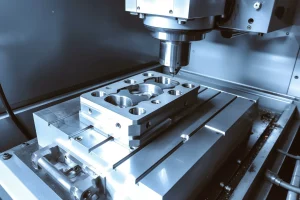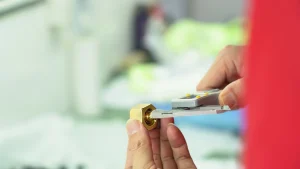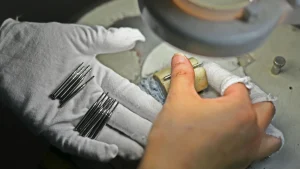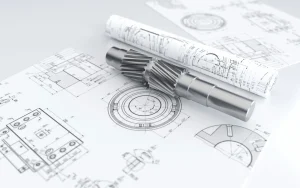In the heart of modern manufacturing, CNC (Computer Numerical Control) machining technology stands as a precision engine, driving the production of everything from tiny medical devices to massive aero engine parts. This technology, which seamlessly blends digital design with physical manufacturing, has become an indispensable cornerstone of modern industry.

Diving into the Industry: Differentiated Applications of CNC Machining
The needs of CNC machining vary widely across industries, and understanding these differences is key to unlocking their value:
1. Aerospace: This is a sector where precision, material properties, and reliability are the most demanding. CNC machining is used to manufacture key engine components (turbine blades, receivers), complex fuselage structural parts, landing gear parts, etc. Difficult-to-machine materials such as titanium alloys, superalloys, and high-strength aluminum alloys are often used, which require extremely high requirements for processing technology, process control, and document traceability (AS9100 standard).
2. Medical Devices: Life and health are crucial, where precision, surface finish, and biocompatibility are paramount. CNC machining is used to manufacture orthopedic implants (joints, bone plates), precision surgical instruments, dental components, diagnostic equipment parts, etc. Stainless steel (e.g., 316L), titanium alloys, cobalt-chromium alloys, and biocompatible plastics (e.g., PEEK, PEI) that meet medical certifications are commonly used.
3. Automotive: Covers from prototype development to mass production, with diverse requirements and large batches. CNC machining is used to manufacture engine block heads, transmission housings, chassis parts, customized modifications, tooling fixtures, and battery modules and motor housings for new energy vehicles. Cost-effectiveness, production efficiency and consistency are required.
4. Electronics/Semiconductors: Miniaturization and refinement are at the core. CNC machining is used to manufacture precision connectors, heat sinks, enclosures, cavities and components for wafer processing equipment, test fixtures, etc. There are extremely high requirements for micron-level accuracy, complex geometries and special surface treatments (e.g. anodizing, passivation).
5. Industrial Equipment: Widely used, requiring robust parts with reliable precision. CNC machining is used to manufacture pump valve housings, gears, drive shafts, mold inserts, automation equipment frames, and core moving parts. A wide range of material options ranges from ordinary steel to engineering plastics.
6. Consumer Electronics: Pursue aesthetic appearance, thinness and precision structure. CNC machining is the preferred process for manufacturing high-end mobile phone/notebook shells, internal structural parts, camera modules, headphone cavities, etc. Aluminum alloys are the most commonly used materials and require extremely high surface treatments (sandblasting, anodizing, high-gloss chamfering).
Beyond the Basics: Core Elements That Determine the Value of CNC Services
When choosing a CNC machining service provider, in addition to price and delivery time, the following professional dimensions are crucial:
1. Equipment Capabilities and Process Expertise:
Equipment type and accuracy: Understand the type of CNC machine tool (three-axis, four-axis, five-axis, turning-mill compound), brand, new and old degree, quantity, and the actual achievable positioning accuracy and repeat positioning accuracy (such as ±0.005mm).
Material experience: Is the service provider proficient in processing the materials you need (such as difficult-to-machine superalloys, thin-walled and deformable parts, special engineering plastics)? Are there proven cutting parameters and tool solutions?
Complex geometry ability: Can you efficiently and high-quality complete challenging structures such as deep cavities, slender cantilevers, microscopic features, and complex surfaces (five-axis advantage)?
Special processes: Do you integrate secondary processing capabilities? Such as precision wire EDM, electrical discharge machining (EDM), laser cutting/welding, sheet metal fabrication, etc.
2. Engineering Support and Design Optimization:
Design for Manufacturability Review: A good service provider will proactively review your design drawings (2D/3D CAD), identify potential manufacturability issues (e.g., sharp corners that cannot be machined, cavities that are too deep or too narrow, risk of thin wall deformation, unnecessarily tight tolerances), and recommend optimizations to significantly reduce costs and time.
Process Planning and Programming: Efficient CAM programming and reasonable process routing are the core of ensuring quality and efficiency. Learn about its programming software and engineer experience.
Rapid Prototyping Support: Can you provide rapid proofing services to accelerate product development iterations?
3. Quality Management System and Process Control:
Certification: Is ISO 9001 (Basic) passed? Certifications for specific industries such as automotive (IATF 16949), medical (ISO 13485), aerospace (AS9100) are crucial.
Inspection capabilities: What precision testing equipment does it have (such as coordinate measuring instruments, height gauges, profilers, surface roughness meters, hardness testers)? Can the first article inspection, process inspection and final inspection be carried out? Do you provide a complete test report?
Documentation and traceability: Are process documents (such as work instructions), inspection records, and material certificates complete and standardized? Is part and lot traceability available?
4. Supply Chain and Operations Management:
Material procurement: Can you provide reliable material procurement channels and material certificates?
Surface Treatment: Does the required surface treatment capabilities (e.g., anodizing, plating, painting, sandblasting, passivation, heat treatment) be integrated? Or do you have stable cooperation with reliable suppliers?
Capacity and Delivery Reliability: Can you meet your bulk needs and urgent orders? What is the historical delivery on-time rate?
Communication and response: Are the communication channels smooth? Is the response timely and professional? Are project progress updates available?
Wise Choice: How to Choose a CNC Machining Service Partner
1. Clear Requirements: Clearly define part drawings (material, tolerances, surface treatment, key features), budget, quantity, expected delivery time, and quality requirements.
2. In-depth research: Preliminary screening through industry recommendations, professional platforms, searches, etc. Focus on the equipment, cases, qualifications and industry focus displayed on its official website.
3. Critical Issue Communication:
Which equipment and routing do you recommend for my specific part (simple drawings or descriptions available)?
What is the experience in machining such materials and precision requirements? Can you share similar cases?
Please describe your quality control processes and inspection equipment, how do you ensure critical dimensions?
Can DFM analysis be performed to optimize my design?
How to solve the surface treatment? How to guarantee the delivery date?
What is the pricing strategy for small batches/large quantities?
4. Proofing Verification: For important projects, small-batch proofing is the most direct and effective way to verify the service provider’s capabilities (quality, delivery, communication). Carefully evaluate the quality of the samples, test reports and communication experience.
5. Comprehensive Evaluation: Don’t just look at the lowest offer. Combine technical capabilities, quality assurance, communication efficiency, service attitude, industry reputation and price. Choose a service provider that provides long-term value and is your reliable extended manufacturing partner.
Epilogue
CNC machining services are far from simple “incoming machining”. In the highly competitive global market, whether you can choose a service partner with deep industry knowledge, advanced technical capabilities, rigorous quality control and excellent engineering support directly determines the performance, cost, speed to market and even market competitiveness of your products. Understanding your own industry needs, delving into the core capabilities of service providers, and establishing partnerships based on professionalism and trust are key strategies for harnessing the power of precision manufacturing and achieving product success. Treat CNC machining as a strategic extension of your R&D and manufacturing capabilities to truly unlock its immense value potential.

